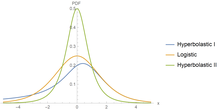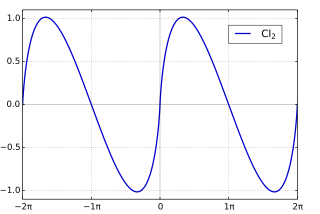The binary hyperbolastic regression of type I
Let  be a binary outcome variable which can assume one of two mutually exclusive values, success or failure. If we code success as
be a binary outcome variable which can assume one of two mutually exclusive values, success or failure. If we code success as  and failure as
and failure as  , then for parameter
, then for parameter  , the hyperbolastic success probability of type I with a sample of size
, the hyperbolastic success probability of type I with a sample of size  as a function of parameter
as a function of parameter  and parameter vector
and parameter vector  given a
given a  -dimensional vector of explanatory variables is defined as
-dimensional vector of explanatory variables is defined as  , where
, where  , is given by
, is given by
 .
.
The odds of success is the ratio of the probability of success to the probability of failure. For binary hyperbolastic regression of type I, the odds of success is denoted by  and expressed by the equation
and expressed by the equation
 .
.
The logarithm of  is called the logit of binary hyperbolastic regression of type I. The logit transformation is denoted by
is called the logit of binary hyperbolastic regression of type I. The logit transformation is denoted by  and can be written as
and can be written as
 .
.
The Shannon information for the random variable  is defined as
is defined as

where the base of logarithm  and
and  . For binary outcome,
. For binary outcome,  is equal to
is equal to  .
.
For the binary hyperbolastic regression of type I, the information  is given by
is given by
 ,
,
where  , and
, and  is the
is the  input data. For a random sample of binary outcomes of size
input data. For a random sample of binary outcomes of size  , the average empirical information for hyperbolastic H1 can be estimated by
, the average empirical information for hyperbolastic H1 can be estimated by
 ,
,
where  , and
, and  is the
is the  input data for the
input data for the  observation.
observation.
The multinomial hyperbolastic regression of type I and II
The generalization of the binary hyperbolastic regression to multinomial hyperbolastic regression has a response variable  for individual
for individual  with
with  categories (i.e.
categories (i.e.  ). When
). When  , this model reduces to a binary hyperbolastic regression. For each
, this model reduces to a binary hyperbolastic regression. For each  , we form
, we form  indicator variables
indicator variables  where
where
 ,
,
meaning that  whenever the
whenever the  response is in category
response is in category  and
and  otherwise.
otherwise.
Define parameter vector  in a
in a  -dimensional Euclidean space and
-dimensional Euclidean space and  .
.
Using category 1 as a reference and  as its corresponding probability function, the multinomial hyperbolastic regression of type I probabilities are defined as
as its corresponding probability function, the multinomial hyperbolastic regression of type I probabilities are defined as

and for  ,
,

Similarly, for the multinomial hyperbolastic regression of type II we have

and for  ,
,

where  with
with  and
and  .
.
The choice of  is dependent on the choice of hyperbolastic H1 or H2.
is dependent on the choice of hyperbolastic H1 or H2.
Multiclass Cross-entropy for hyperbolastic H1 or H2
Multiclass cross-entropy compares the observed multiclass output with the predicted probabilities. For a random sample of multiclass outcomes of size  , the average multiclass cross-entropy
, the average multiclass cross-entropy  for hyperbolastic H1 or H2 can be estimated by
for hyperbolastic H1 or H2 can be estimated by

The log-odds of membership in category  versus the reference category 1, denoted by
versus the reference category 1, denoted by  , is equal to
, is equal to

where  and
and  . The estimated parameter matrix
. The estimated parameter matrix  of multinomial hyperbolastic regression is obtained by maximizing the log-likelihood function. The maximum likelihood estimates of the parameter matrix
of multinomial hyperbolastic regression is obtained by maximizing the log-likelihood function. The maximum likelihood estimates of the parameter matrix  is
is


















































































































































